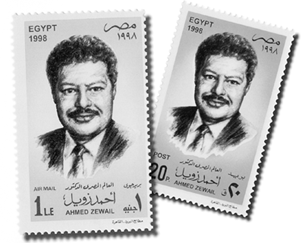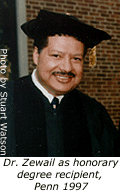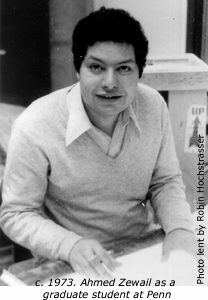
 |
|
 |
The U.S. government has awarded him the E.O. Lawrence Award; Egypt's President Mubarak conferred on him the Order of Merit, first class, in 1995; and last year Egypt issued two postage stamps in his honor, an accolade that touched him, as he told the Pennsylvania Gazette, by putting him "in the company of stamps honoring the pyramids, Tutankhamen and Queen Nefertiti." |
 In 1997 Dr. Zewail came back to Penn for an honorary degree--one of
six he now holds--and his citation said, in part, "The world scientific
community has applauded your remarkable achievements, heaping upon you its
highest honors...Your greatest honor, however, and the true measure of your
profound effect upon the field will be found in the accomplishments of those
who build upon your work."
In 1997 Dr. Zewail came back to Penn for an honorary degree--one of
six he now holds--and his citation said, in part, "The world scientific
community has applauded your remarkable achievements, heaping upon you its
highest honors...Your greatest honor, however, and the true measure of your
profound effect upon the field will be found in the accomplishments of those
who build upon your work."
_____________
* For the 1997 Prize to Dr. Stanley Prusiner, C '64, M'68, see Almanac October 7, 1997.
 Capturing the Femtosecond
Capturing the Femtosecond
What would a football match on TV be without "slow motion" revealing afterwards the movements of the players and the ball when a goal is scored? Chemical reactions are a similar case. The chemists' eagerness to be able to follow chemical reactions in the greatest detail has prompted increasingly advanced technology. This year's laureate in Chemistry, Ahmed H. Zewail, has studied atoms and molecules in "slow motion" during a reaction and seen what actually happens when chemical bonds break and new ones are created.
Zewail's technique uses what may be described as the world's fastest camera. This uses laser flashes of such short duration that we are down to the time scale on which the reactions actually happen--femtoseconds (fs). One femtosecond is 10-15 seconds, that is, 0.000000000000001 seconds, which is to a second as a second is to 32 million years. This area of physical chemistry has been named femtochemistry.
Femtochemistry enables us to understand why certain chemical reactions take place but not others. We can also explain why the speed and yield of reactions depend on temperature. Scientists the world over are studying processes with femtosecond spectroscopy in gases, in fluids and in solids, on surfaces and in polymers. Applications range from how catalysts function and how molecular electronic components must be designed, to the most delicate mechanisms in life processes and how the medicines of the future should be produced.
--From the Academy's Press Release
Dr. DiIulio, the Frederick Fox Leadership Professor and Director of the Program |
Two Fox Leadership ProfessorsDean Samuel H. Preston has announced the selection of Dr. John I. DiIulio and Dr. Martin E. Seligman as the first holders of two new chairs established this year as part of the Fox Leadership Program (Almanac May 4). The $10 million program endowed by Trustee Robert A. Fox, C '52, provides for a third professorship. The gift will also support an extensive program of activities bringing together undergraduates with leaders from a variety of fields, providing them with the tools of leadership through curriculum, and offering opportunities to demonstrate leadership. "I don't think that any university in the country can boast two faculty members who better embody leadership ideals in their research and in their lives than John DiIulio and Marty Seligman," the Dean said. [Please see profiles here.] |
Dr. Martin Seligman, the Robert A. Fox Leadership Professor |
Almanac, Vol. 46, No. 8, October 19, 1999
| FRONT PAGE | CONTENTS | JOB-OPS | CRIMESTATS | TAT: Speaking Across the University--and in the Classroom | TALK ABOUT TEACHING ARCHIVE | BETWEEN ISSUES | OCTOBER at PENN |
 Dr. Ahmed H. Zewail,
the Linus Pauling Professor at CalTech who took his Ph.D. at Penn in 1974,
has won the 1999 Nobel Prize in Chemistry for his work leading to the birth
of the field of femtochemistry--a breakthrough that has allowed high--speed
cameras to take pictures of molecules in the process of undergoing chemical
reactions. When he accepts the $950,000 award of the Royal Swedish Academy
of Sciences in Stockholm on December 10, he will be the second Penn alumnus
in three years to win the Prize.
Dr. Ahmed H. Zewail,
the Linus Pauling Professor at CalTech who took his Ph.D. at Penn in 1974,
has won the 1999 Nobel Prize in Chemistry for his work leading to the birth
of the field of femtochemistry--a breakthrough that has allowed high--speed
cameras to take pictures of molecules in the process of undergoing chemical
reactions. When he accepts the $950,000 award of the Royal Swedish Academy
of Sciences in Stockholm on December 10, he will be the second Penn alumnus
in three years to win the Prize.
